by Federico Giannini (Instagram: @federicogiannini1), published on 11/08/2016
Categories: Exhibition reviews
/ Disclaimer
Review of the exhibition "Daniel Spoerri. A Hard Choice" in Carrara, Plastic Arts Center, as part of Carrara Marble Weeks 2016 (through 11/09).
Article originally published on culturainrivera.it
The title of an art exhibition can be powerfully revealing. Often it is so in a negative way: those familiar with the world of exhibitions by now already know more or less what to expect from the title, given moreover the conformism that characterizes most organizers and curators. But it can also be variously interpretable: such is the case with the Daniel Spoerri exhibition. A Hard Choice, the main exhibition of the Carrara summer, spearheading the Carrara Marble Weeks poster. Who makes a tough choice in the end? Pretty much everyone: Daniel Spoerri, whose research is a continuous evolution always driven by that conviction (“easel painting has had its day”) around which Pierre Restany elaborated the manifesto of nouveau réalisme, later signed by several artists, including Spoerri himself. The public, called to visit (but one could safely say “to take part in”) an exhibition by an artist whose language has already entered the “official canons” of art history but which is not among the most immediate and easy for those accustomed to tradition (and it is undeniable that Carrara is strongly rooted in its own tradition). The curator, Luciano Massari, who literally had to choose about 40 works mostly from private collections to document the Swiss-Romanian artist’s long journey.
Something, inevitably, is left out. Missing, for example, are the so-called Oracles, among Spoerri’s most recent achievements, which would also have fit nicely into the itinerary conceived by Massari, not least to visually illustrate what critic Antonio d’Avossa asserted in the catalog essay: “that of Daniel Spoerri is a unique aptitude that presents itself in that great fresco of contemporary art history as a real language, with rules and exceptions, with cases and conjugations, and above all with a great variety of poetic intuitions that make it astonishing, in its production of growing contradictions between the sense of modernity and the sense of classicity.”
However, a first, glaring example of this tendency to bring together “sense of modernity” and “sense of classicity” in order to bring out all the contradictions, is found immediately at the beginning of the itinerary: the Cat and the Fox are two bronze sculptures reproducing the corpses of the two animals. A “Still Life” of classical memory in the true sense of the word. And which comes back as a protagonist at the end, in a work from the series Histoires des Boîtes à Lettres ( “Stories of the Mailboxes”), where the most disparate objects (a knife and three mummified animals in number 10 of the series, or, in The Weight of Magic, the first work of the itinerary, a stadera from which hangs a box full of knick-knacks-memories, memories? - and a reproduction of a hand) are attached to boards on which a bed of typefaces has been laid out. The typefaces are used to communicate; with the typefaces letters are written that will be sent to all parts of the world, telling the most varied stories (whether real or fanciful, related to true events, to more or less disturbing dreams, or to memories) and that will themselves become part of a story.
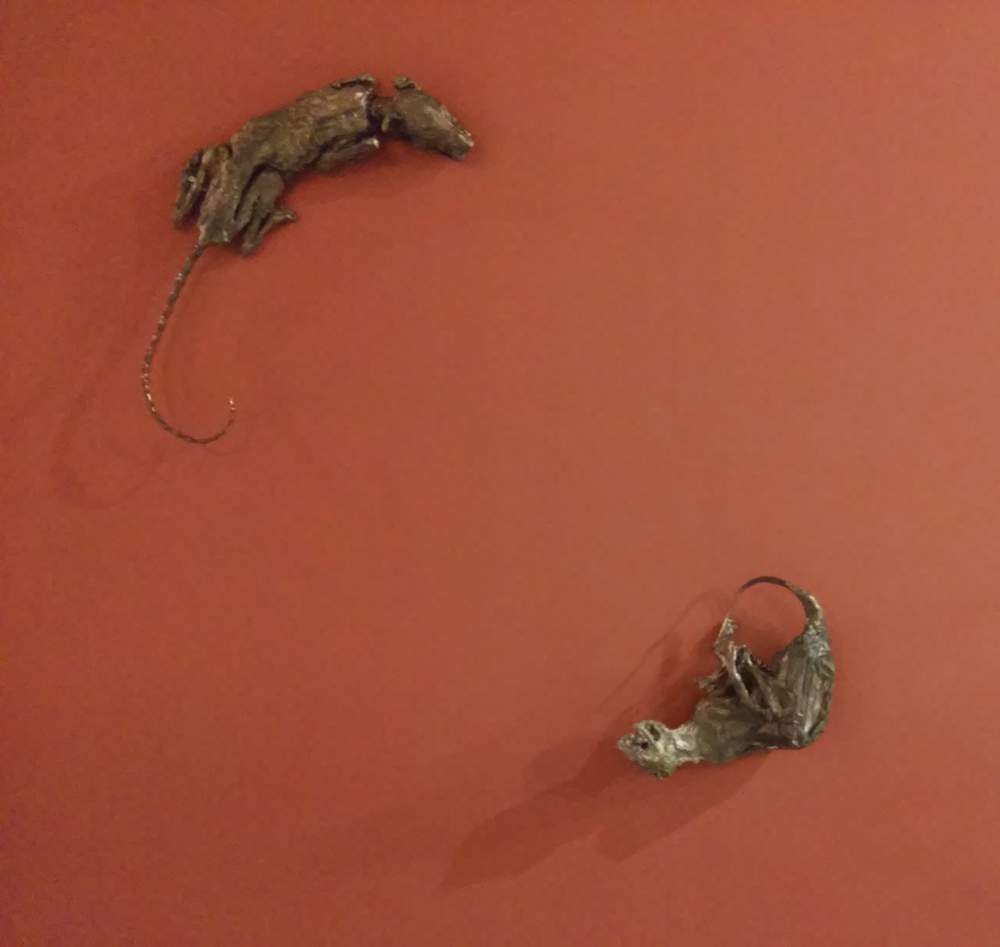 |
| Daniel Spoerri, The Cat and the Fox (bronze casting) |
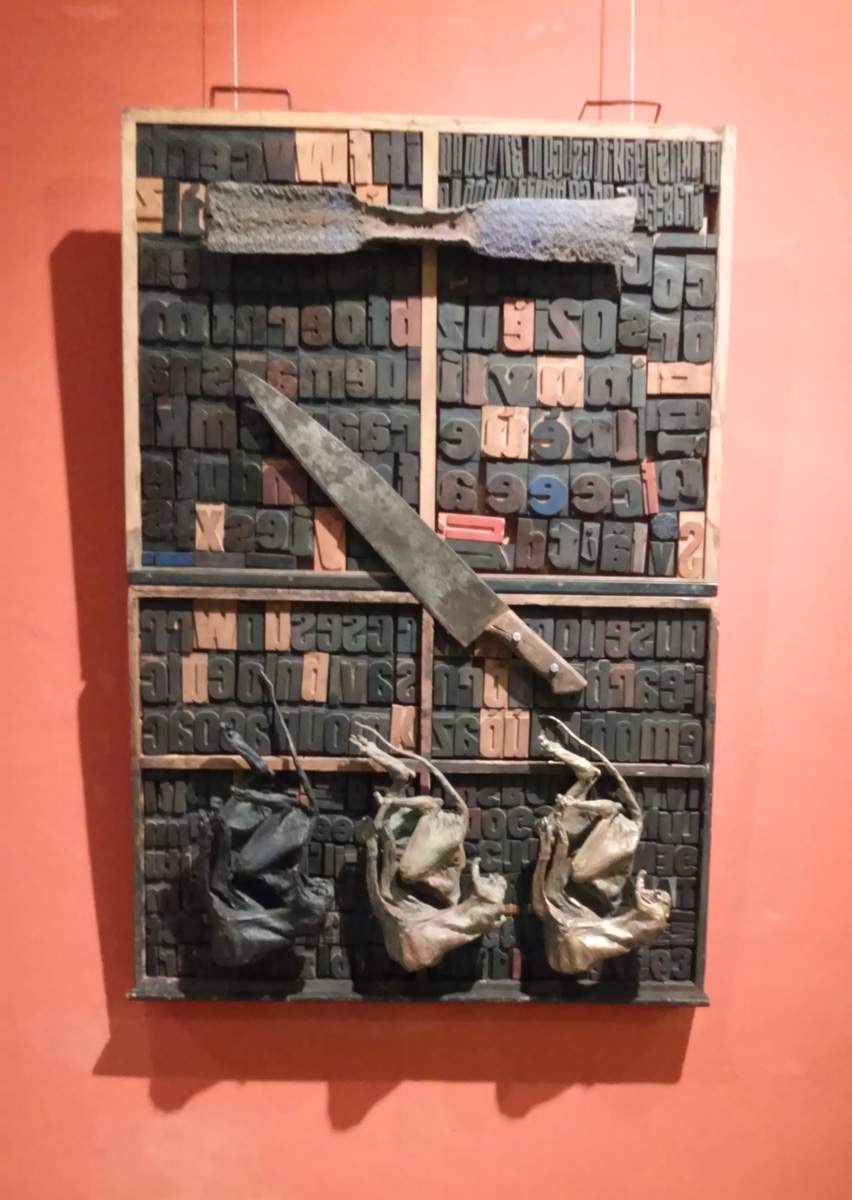 |
| Daniel Spoerri, Histoires de Boîtes à Lettres, vol. 10 (2003; assemblage, 125 x 80 x 66 cm) |
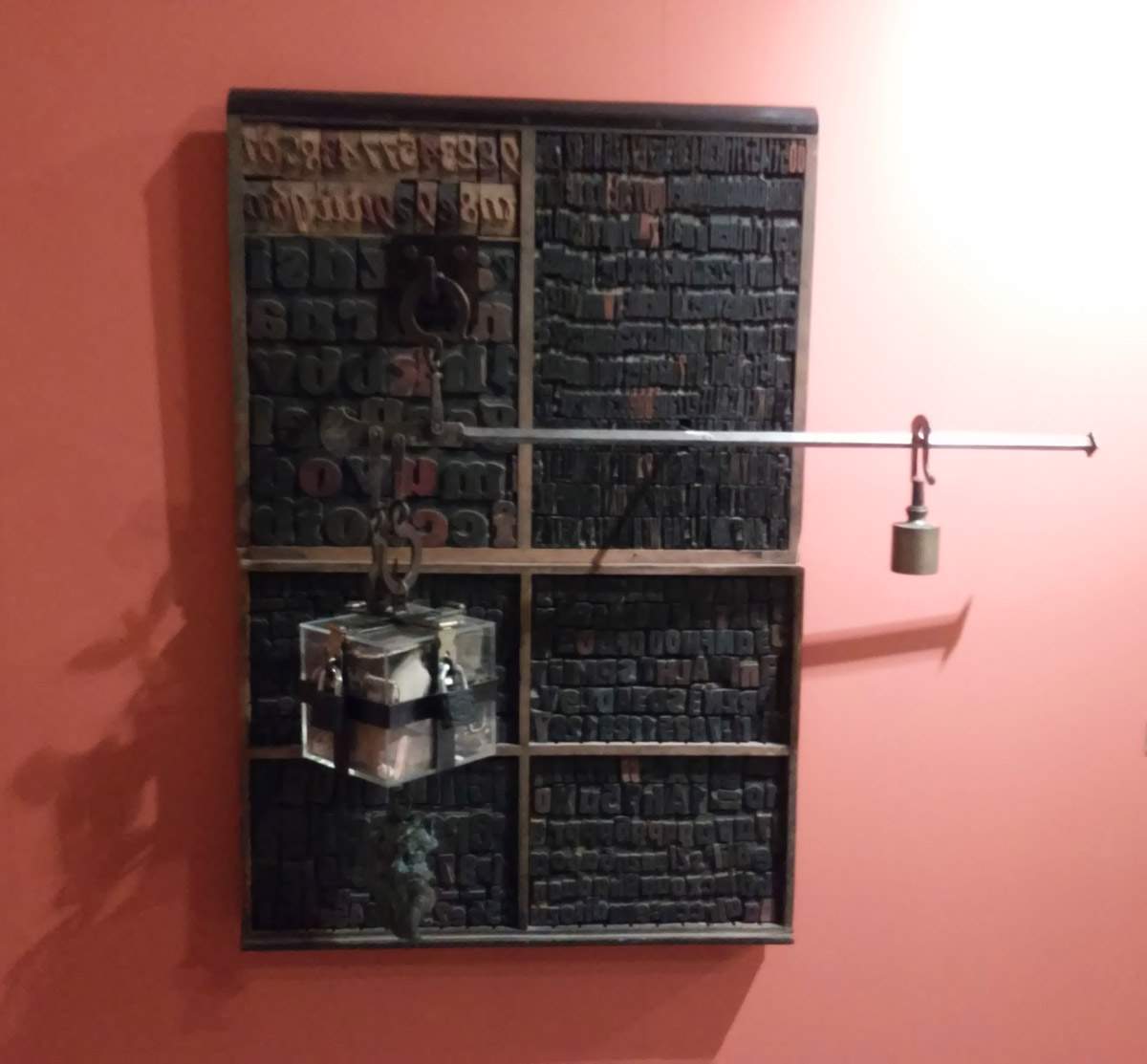 |
| Daniel Spoerri, The Weight of Magic (Assemblage) |
The Histoires des Boîtes à Lettres, conceived in the late 1990s and early 2000s, are part of the artist’s latest research: the fact that a work from the series was exhibited at the opening of the itinerary could thus be read as a declaration of intent, because then the exhibition follows an essentially chronological path that begins with a reference to tableaux pièges, the famous “trap paintings” through which, since the 1960s, Daniel Spoerri has fixed on vertical supports objects found in reality and proposed to the viewer in the exact position in which the artist found them. Only vertically, instead of horizontally. Recalling this strand is a work such as the Fallen Table: it differs from the tableaux pièges of the beginnings because in this case the objects slide toward the ground going to break on the floor communicating, moreover, a dynamism not very frequent in Spoerri’s art. The objects in question are nothing more than what one would find on a table set with the remains of a meal: water and wine bottles, corks, open and emptied breadstick packages.
This is, after all, the way Spoerri conducts his critique of consumer society: through that "eat art" invented by the artist (art in which the protagonist is food), Spoerri questions what our relationship with food is. A relationship certainly full of contradictions, which explode with all their distressing consequences in one of the most terrifying works in the exhibition, the Phantom of Hunger: an assemblage of disparate objects, mostly toys, surmounted by an old fencing mask on which Spoerri has added a Venetian Zanni mask. Unicef recently released a statistic according to which more than three million children under the age of five die of hunger every year in the world: we can only say that these are reflections induced by the observation of Daniel Spoerri’s works. And it is no coincidence that another, if you will, even more terrible work was placed next to the Phantom of Hunger : the Nativity in reverse, with a stuffed stork carrying the skeleton of a child. An atrocious contemporary reinterpretation of a classic theme, that of the memento mori.
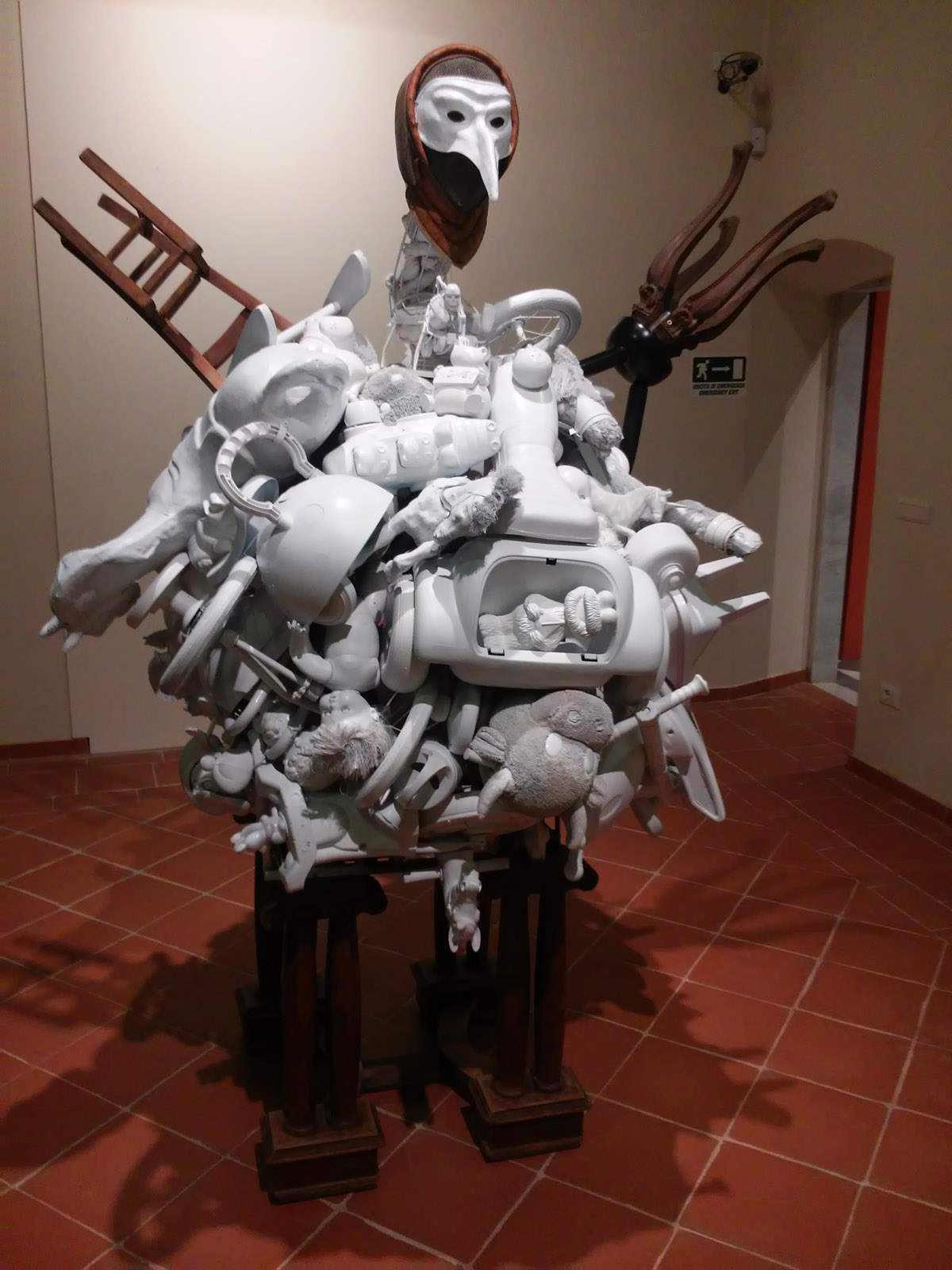 |
| Daniel Spoerri, The Ghost of Hunger (Assemblage, h. 220 cm) |
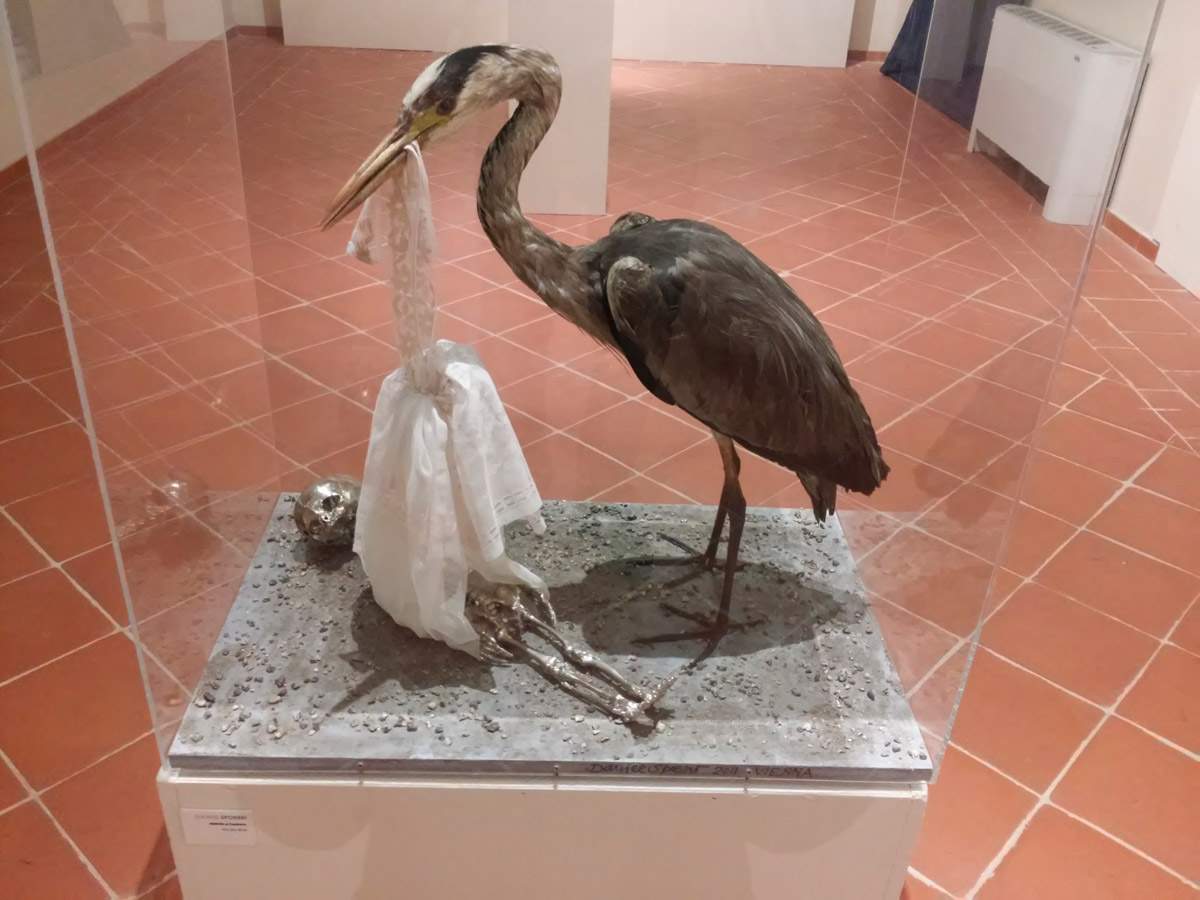 |
| Daniel Spoerri, Nativity in Reverse (Assemblage, 120 x 60 x 90 cm) |
Indeed, it must be said that one of the characteristics of Daniel Spoerri’s work is to conduct a continuous reflection on the relationship between life and death. At the beginning of the exhibition we find two works that strike a strong chord, such as Pêche interdite ( “Forbidden fishing”) and To knot or not to be (an untranslatable pun in Italian that plays on theassonance between “knot,” “knot,” and “not,” “not”-it could be rendered, perhaps foolishly, as “To be or not to be”). The first is a 1979 work belonging to the series of Investigations criminelles ( “Criminal Investigations”): using the same procedure as the tableaux pièges, the artist hangs a photograph of a woman killed by drowning and a series of objects that reconstruct the investigation of the crime on the table. With the second Spoerri probes the possibility for everyday objects to turn into lethal weapons: the horrifying photograph of a man hanged and left hanging for who knows how many hours is flanked by ropes that tighten into knots of various kinds.
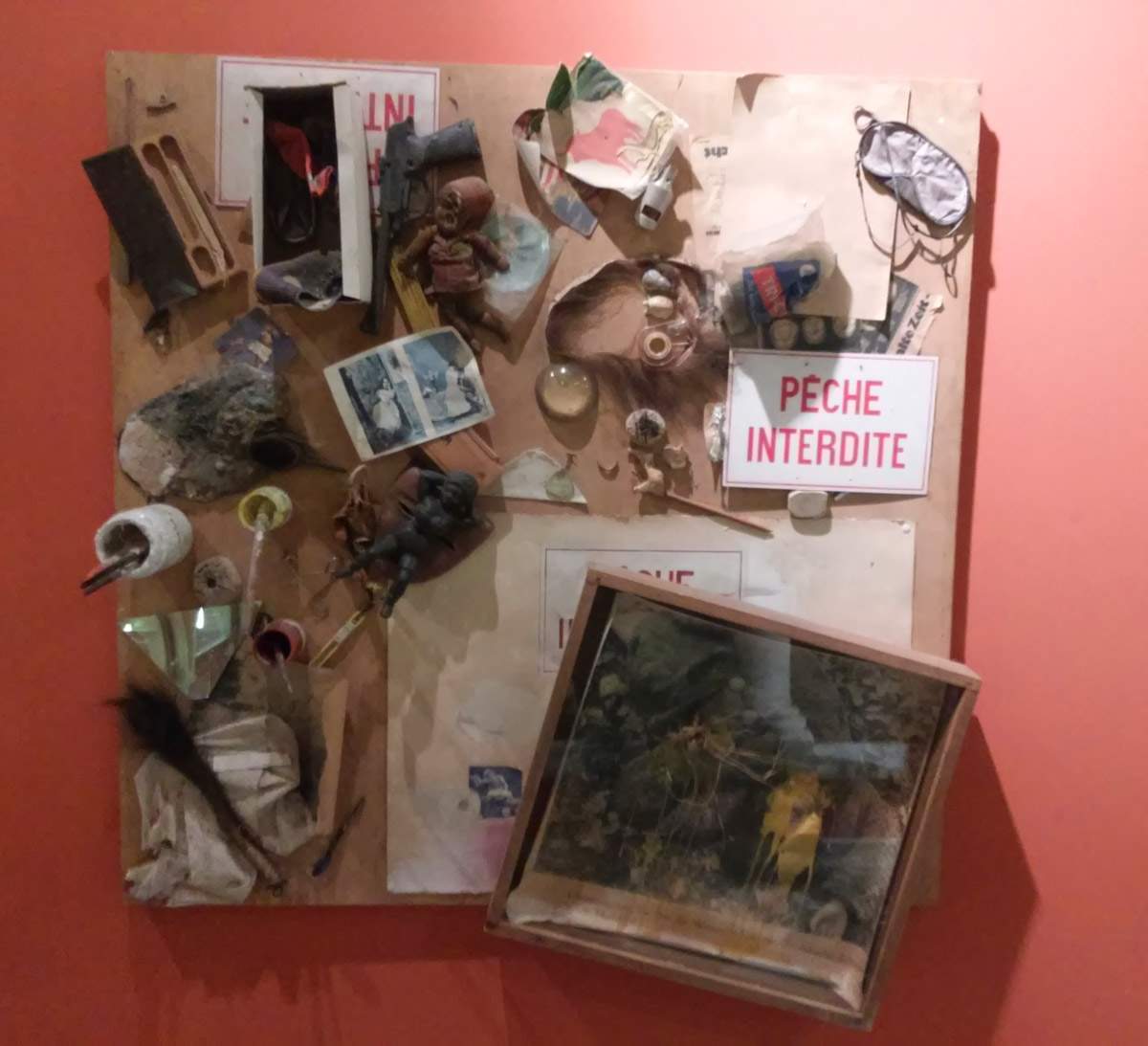 |
| Daniel Spoerri, Pêche interdite (1979; assemblage, 134 x 34 x 20 cm) |
Two of the main themes of Spoerri’s art, nourishment and the end, come back together in what is probably the grandest of the works on display in the exhibition, TheLast Supper, which the visitor finds roughly halfway along the path, after the Investigations criminelles. The LastSupper is a series of thirteen Carrara marble panels (it was in the Apuan city that the work was conceived) representing as many last suppers of great personalities in history, from Socrates to Duchamp via Proust and Freud without forgetting, of course, Jesus Christ (his is the largest marble panel, placed in the center). Spoerri researched what all these figures had eaten at their last meal and produced this series where the sculpted marble objects and plates are reminiscent of tableaux pièges: a kind of ennobling, given the material and characters, of the strand the artist has practiced for much of his career. And similar to tableaux pièges are the artist’s latest works in the exhibition, such as The Genetic Chain of the Flea Market or Erst letzt das erste ( “First the last the first”) where Daniel Spoerri’s passion for accumulation is again made manifest.
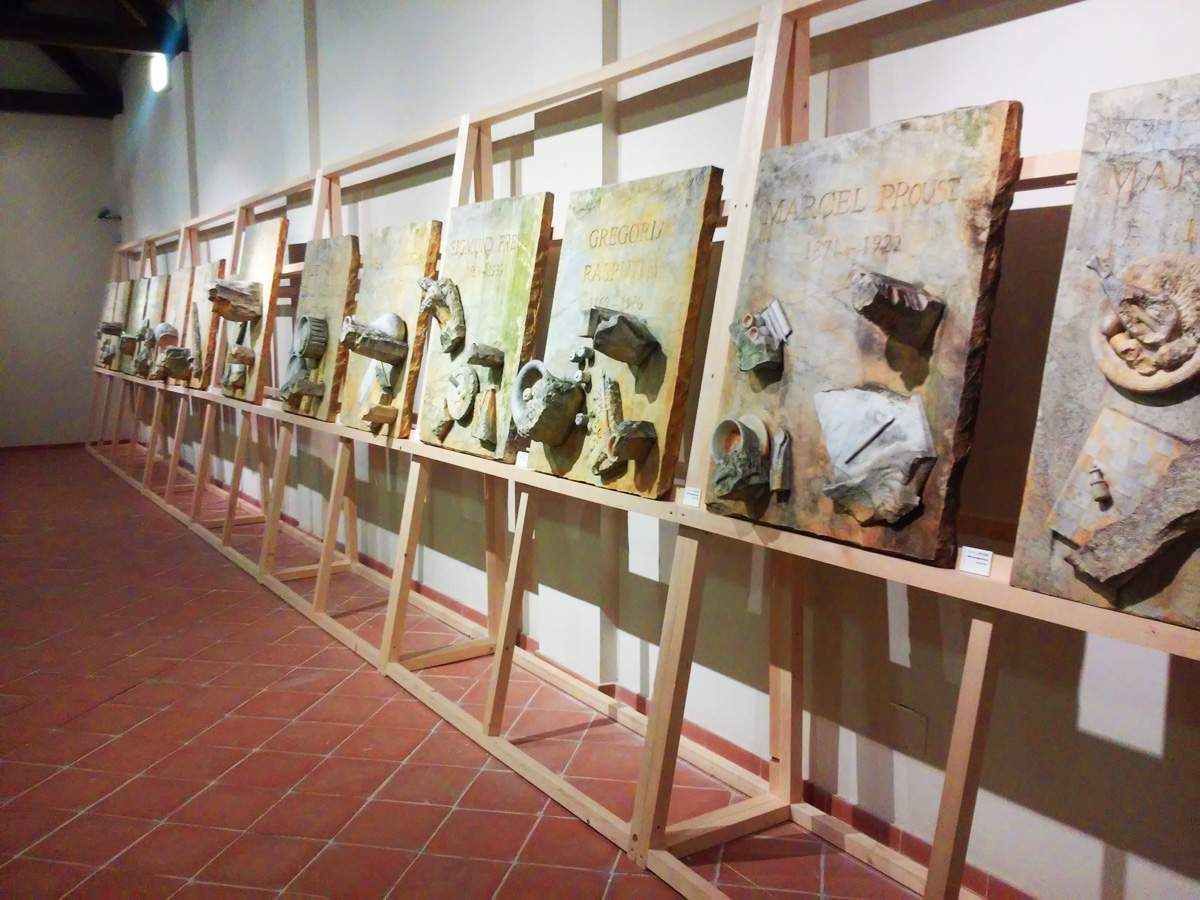 |
| Daniel Spoerri, Last Supper (13 plates in Carrara marble) |
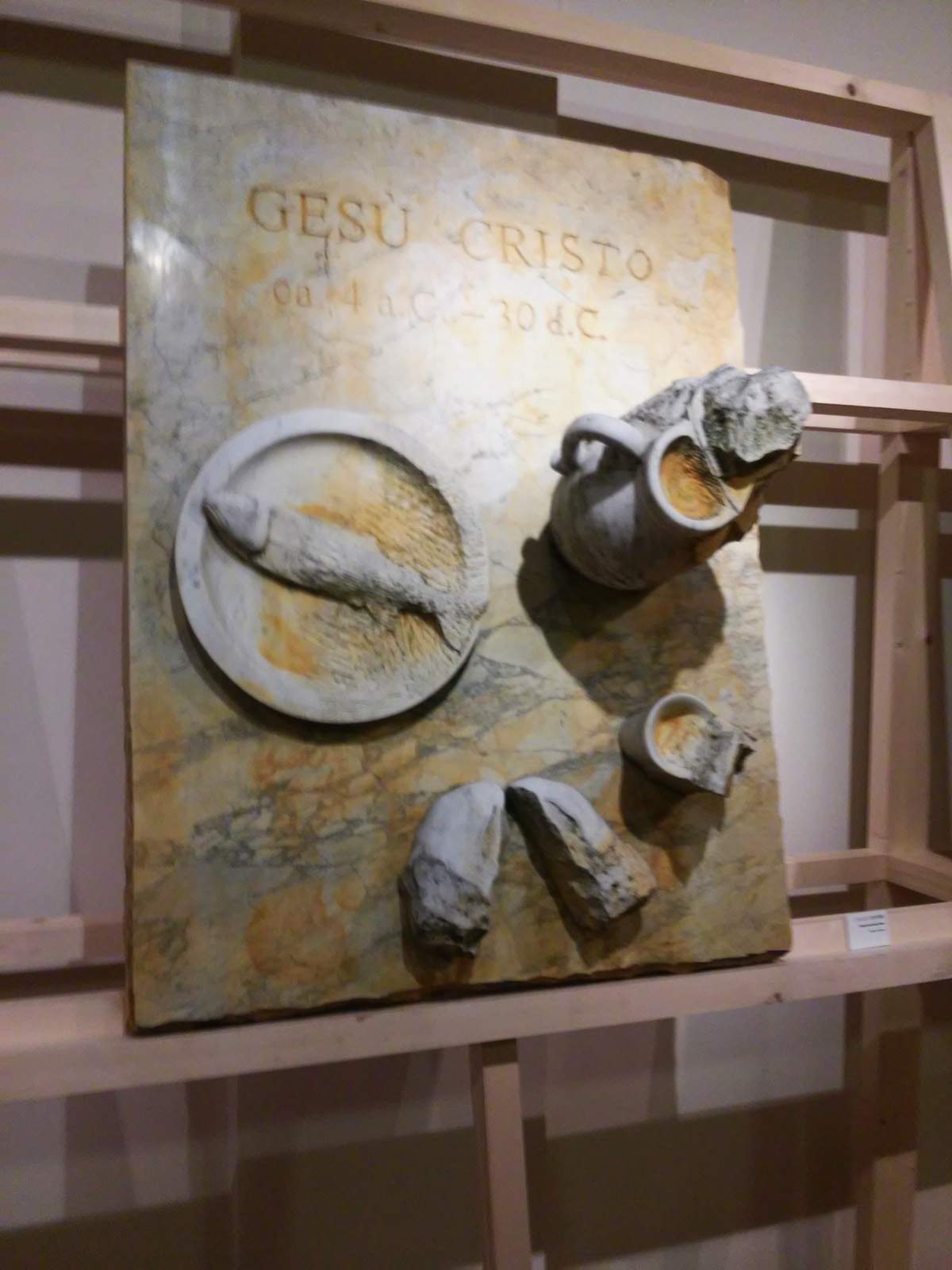 |
| Daniel Spoerri, Last Supper - Jesus Christ (Carrara marble) |
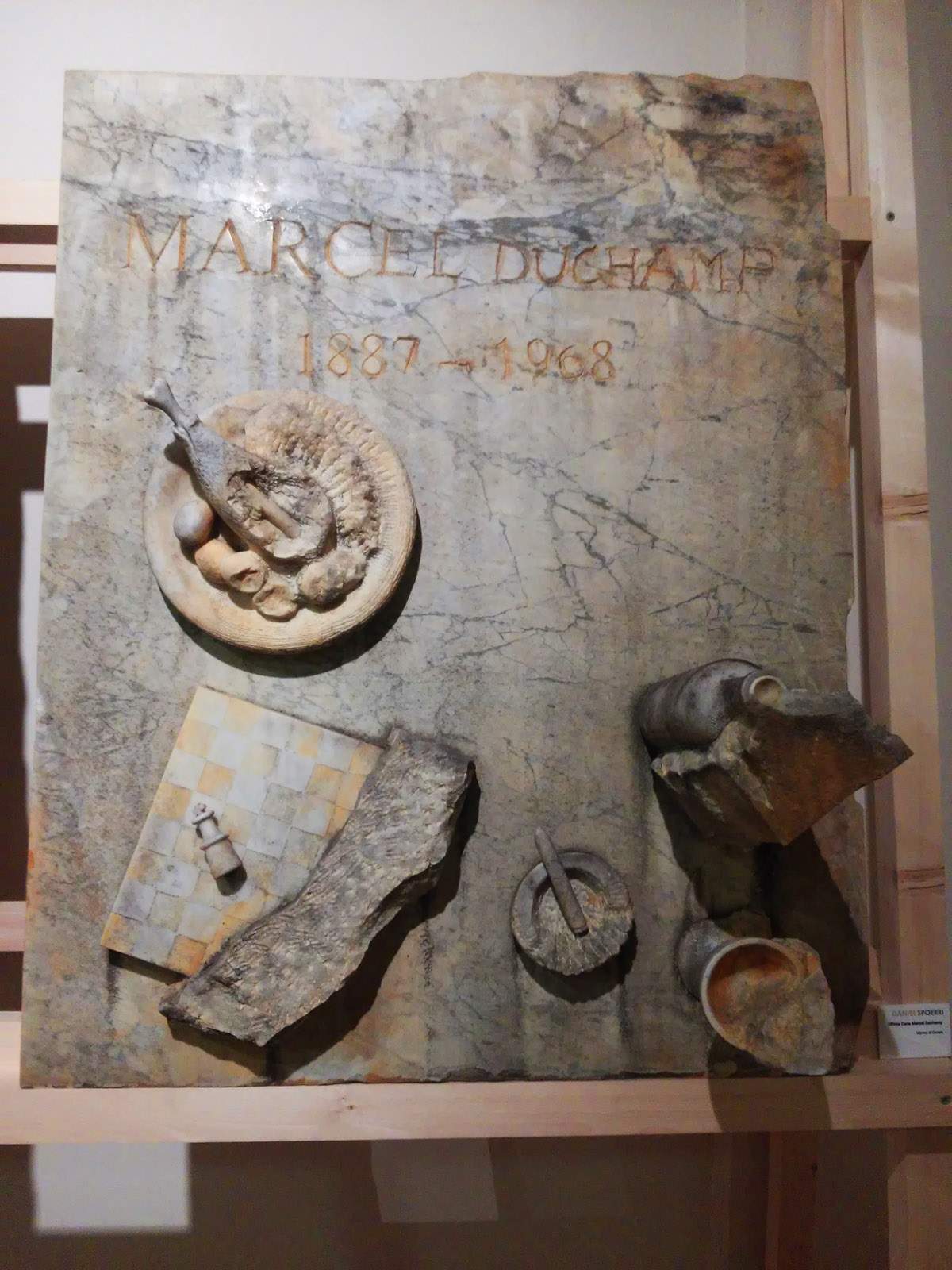 |
| Daniel Spoerri, Last Supper - Marcel Duchamp (Carrara marble) |
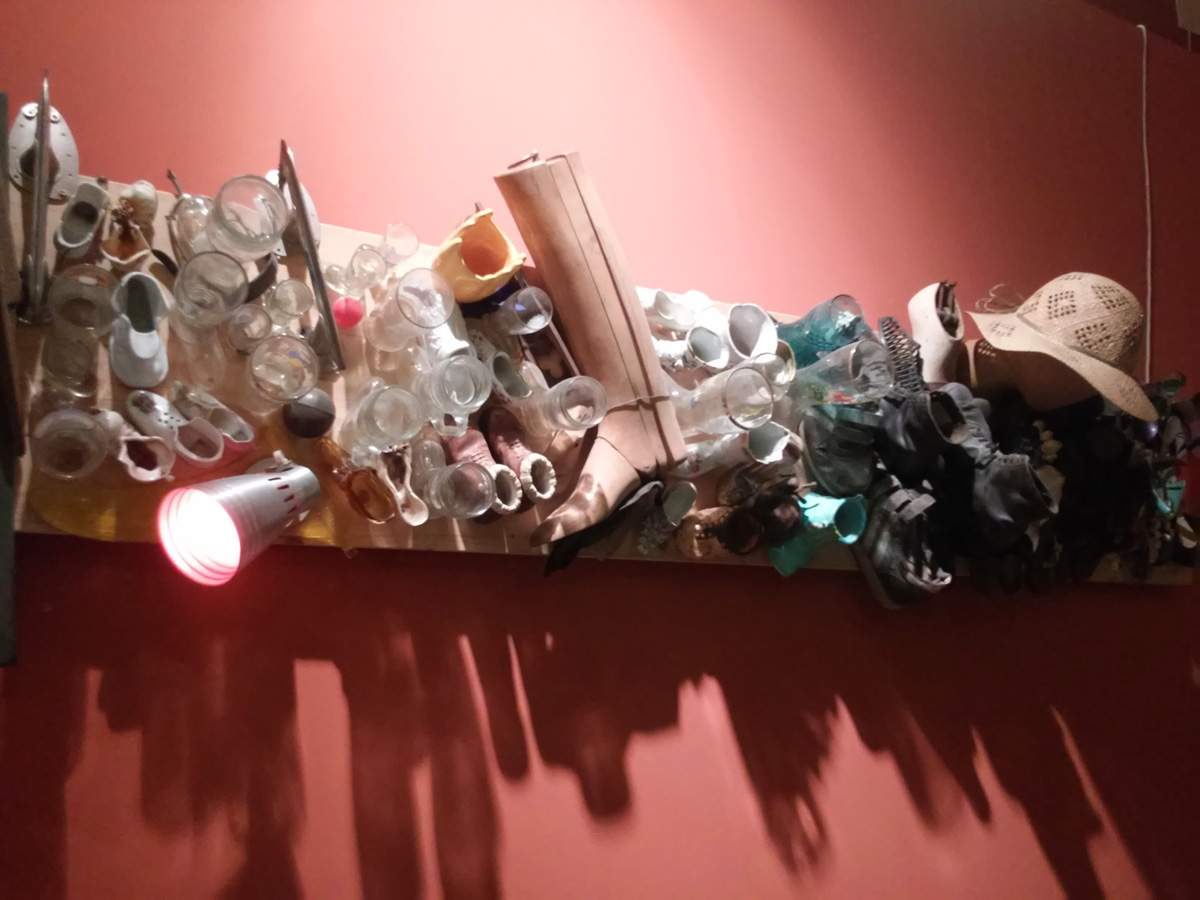 |
| Daniel Spoerri, Genetic Chain of the Flea Market, detail (assemblage) |
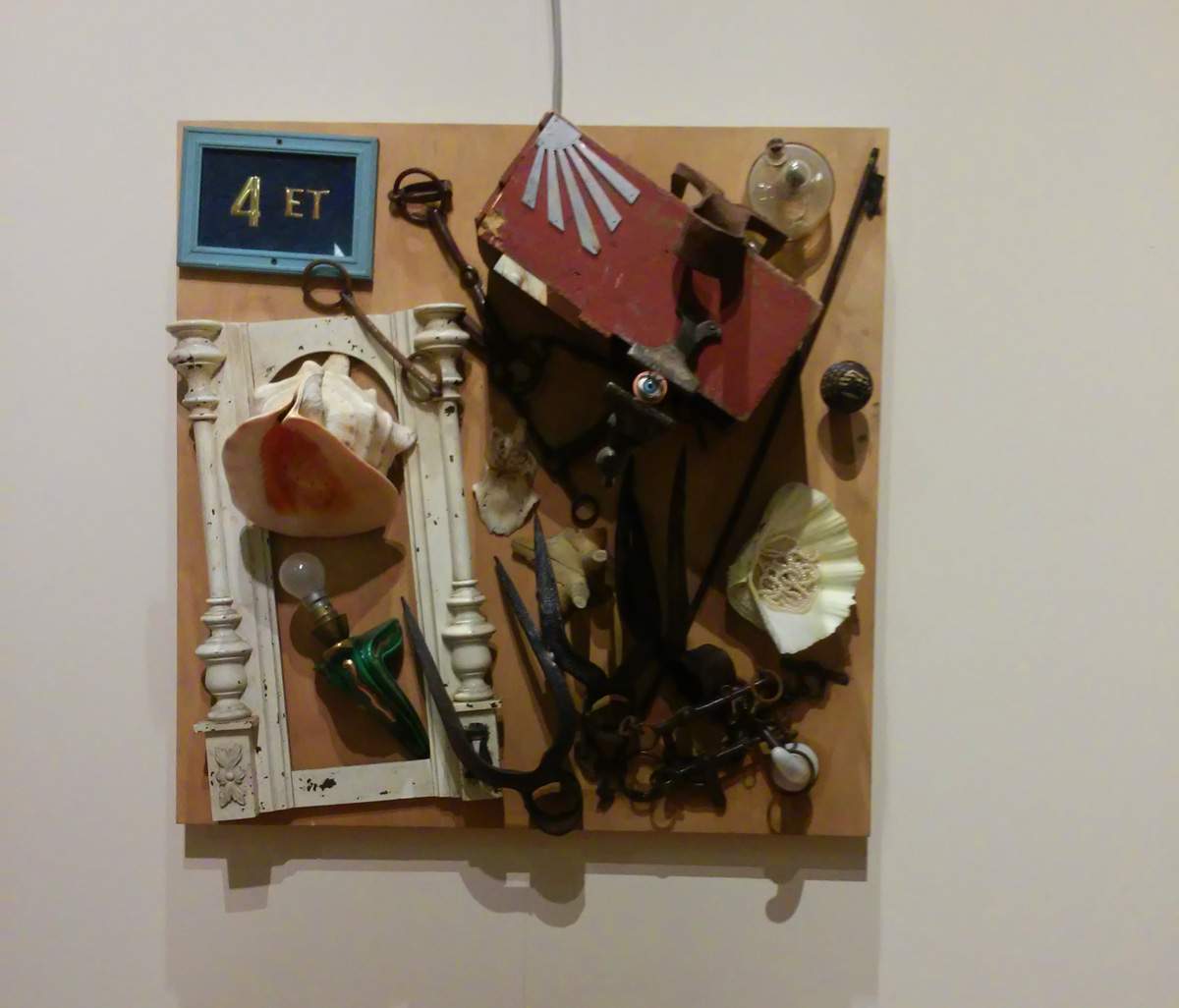 |
| Daniel Spoerri, Erst letzt das erste (2009-2010; assemblage, 75 x 75 cm) |
Daniel Spoerri’s art is pure ugliness. But if his art tells of ugliness, of uselessness, of garbage, of violence, of extreme accumulation, it does so because this is how the artist sees reality, and above all because this is how reality presents itself to the artist’s (and our) eyes: the presupposition of nouveau réalisme is no longer to present reality in the form of an imitation to be depicted in a painting or sculpture, but rather to make real objects speak directly. The French philosopher Mattéi was elevating Spoerri’s objects to a paradigm of the supposed nihilism of our society as well as the inability of much contemporary art to make itself the bearer of meaning. Indeed, those who expect to find messages may be disappointed, but this does not mean that Spoerri’s art has no meaning: the artist, in fact, narrates. Spoerri’s objects speak in a chilling, often brutal way, and it is above all this violent component, which tells us of a less than idyllic reality, that emerges from the Carrara exhibition. The only hope is entrusted to the installation that extends the exhibition to the Aula Magna of theAcademy of Fine Arts, and which is titled L’ombelico del mondo (The Navel of the World), from 1991: nine unicorns in a circle, installed in the center of the room, that come from the artist’s garden in Seggiano. A possible reconciliation with the world of fantasy, with antiquity (the chosen number, nine, is full of symbolic references), and with an uncontaminated purity, of which the unicorn is a symbol.
The exhibition’s main problem lies in the fact that many of the above-mentioned passages cannot be grasped, even in the basic coherence of a path that develops following a certain chronological rigor (and thus, essentially, proceeds by themes, because Spoerri’s various researches are punctuated in a rather regular way along the span of his artistic career). This is a problem common to most contemporary art exhibitions, which often make use of poor communicative apparatuses or, as in the case of Daniel Spoerri. Hard choice, almost entirely absent. The fact that contemporary art has problems of communicability with the public, which also emerged from the Carrara exhibition, should have been a stimulus to the organizers: for a well-conceived itinerary, such as that of the exhibition is, after all (to be objected to just the lack of some tableaux pièges from the early days, which is felt especially at the beginning, when the visitor is forced to make a rather long jump to the 1970s, as well as that of the oracles and also of the détrompe l’oeil), an equally well-conceived didactic apparatus for the public would have been essential for full success. Subject to these shortcomings, the operation is certainly to be promoted.
Click here for all information about the exhibition
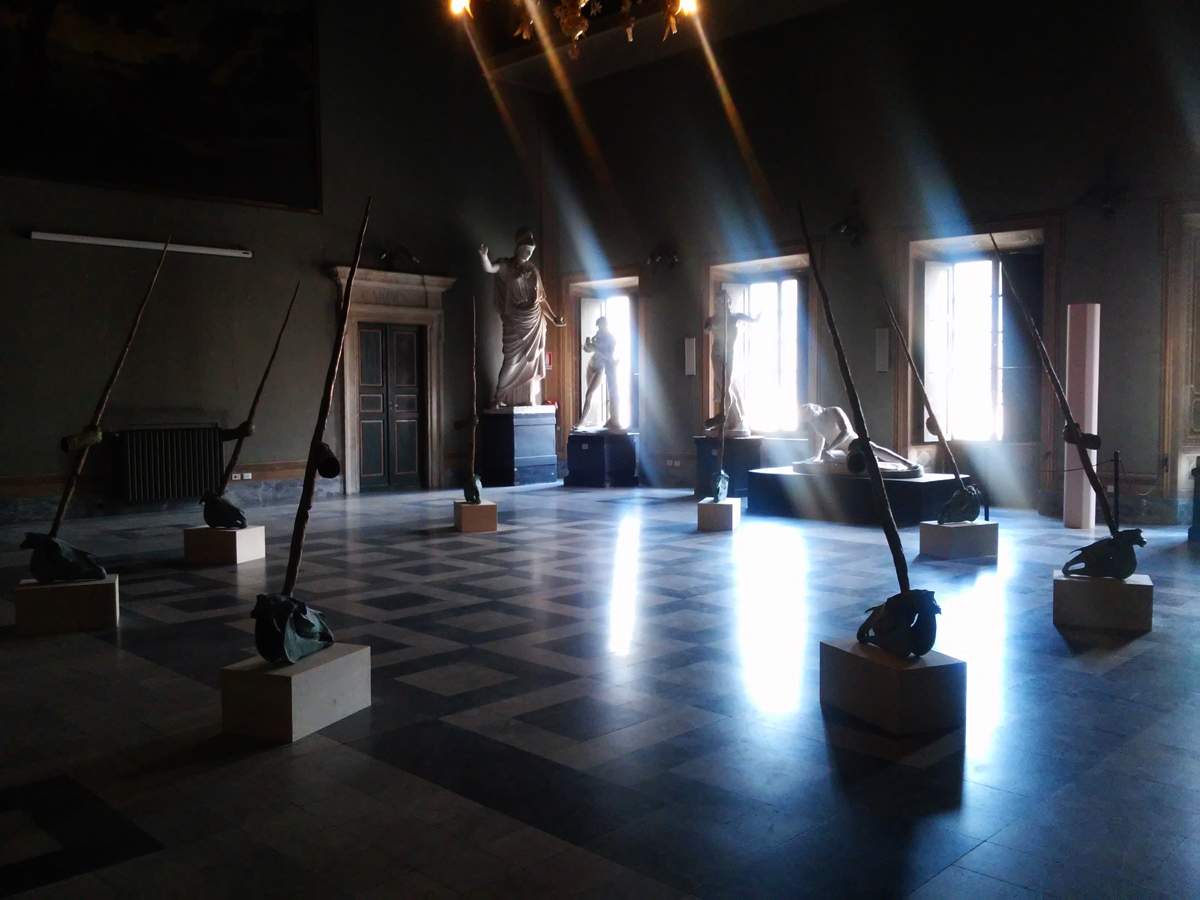 |
| Daniel Spoerri, The installation “The Navel of the World” at the Academy of Fine Arts in Carrara, Italy |
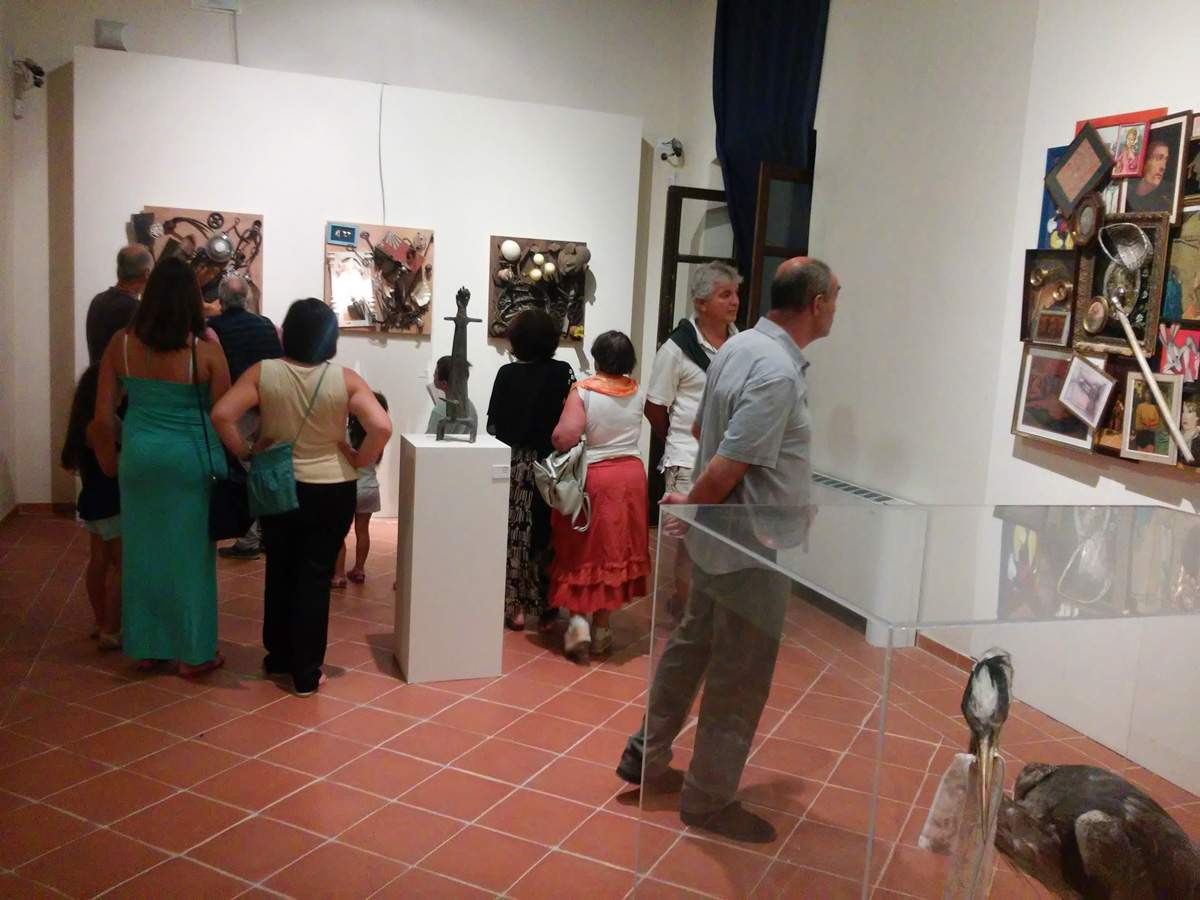 |
| Audience at the exhibition “Daniel Spoerri. A Hard Choice.” |
Warning: the translation into English of the original Italian article was created using automatic tools.
We undertake to review all articles, but we do not guarantee the total absence of inaccuracies in the translation due to the program. You can
find the original by clicking on the ITA button. If you find any mistake,please contact us.








































